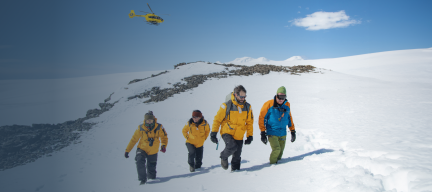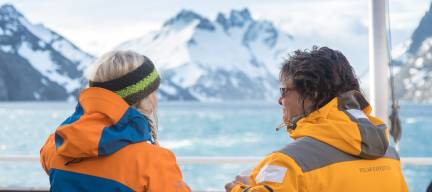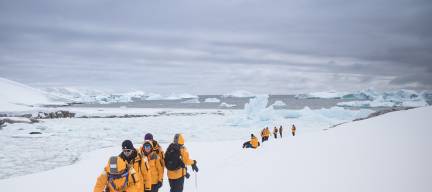Svalbard, a Norwegian archipelago deep within the Arctic Circle, presents a unique blend of untouched landscapes and hardy wildlife. Often called the “Wildlife capital of the Arctic,” Svalbard offers an unforgettable journey into a remote wilderness. This guide provides an in-depth look at exploring Svalbard, detailing what you can expect from expeditions, the iconic wildlife you’ll encounter, and how to responsibly experience this Arctic jewel.

Choosing the Right Expedition. Forget any preconceived notions you have about traditional cruises; Svalbard expeditions are voyages to what feels like the end of the world. Some expeditions aim to circumnavigate the Svalbard archipelago, although itineraries are subject to change due to weather conditions and potential wildlife sightings.
As you plan your voyage, keep an eye out for Arctic cruise Svalbard options, as they often provide specialized experiences. Here are a few factors to consider as you make your choice:
- Ship Size: Smaller ships, such as those accommodating only 200 passengers, offer greater flexibility, a more intimate experience, and can go places larger ships can’t.
- Itinerary Length: Expeditions typically range from 7 to 14 days, allowing ample time to explore various points of interest.
- Specific Interests: Some cruises focus on specific activities like Zodiac tours, hiking, or kayaking.
For instance, the “Svalbard Explorer: Best of High Arctic Norway” expedition offers a comprehensive 10-day introduction to the region, with opportunities to spot walruses, reindeer, and polar bears amidst continuous daylight.
Departure Points and Routes

Most Svalbard expeditions start and end in Longyearbyen, the largest settlement in Svalbard. A typical circumnavigation heads north towards Krossfjorden’s 14th of July Glacier and Liefdefjorden’s Monaco Glacier. Conditions permitting, some voyages may reach the Seven Islands, marking the northernmost point of the journey.
Wildlife Encounters

Iconic Arctic Species. Svalbard is renowned for its abundant wildlife, including polar bears, walruses, and reindeer. The waters around Svalbard teem with marine life, such as seals and whales. Lucky visitors might spot Arctic birds like the Ivory Gull, often an indicator of nearby polar bears.
Best Times for Wildlife Viewing.
The optimal time to visit Svalbard for wildlife viewing is during the summer months when the sea ice is at its lowest. During this time, there’s around a 50% chance of a successful circumnavigation in July.

Responsible Wildlife Viewing.
Observing wildlife in their natural habitat is a privilege that comes with responsibilities:
- Maintain a safe distance from animals to avoid disturbing them.
- Follow AECO guidelines and instructions provided by Expedition Leaders to minimize your impact on the environment.
- Never feed or approach wildlife.
Experiencing the Landscape

Tundra and Glaciers. Svalbard’s landscape is characterized by vast tundra, polar deserts, and stunning glaciers. Excursions often include guided walks on the tundra, offering close encounters with Svalbard reindeer and unique flora. Zodiac cruises provide opportunities to explore glaciers, fjords, and icebergs up close.
Historical and Geological Significance. Bellsund offers insight into the region’s history and wildlife. You can see beluga whale skeletons at Ahlstrandhalvøya, and healthy beluga pods can still be spotted in the side fjords.
Choosing Your Arctic Cruise
When choosing an arctic expedition cruise, consider these itineraries:
- Spitsbergen Circumnavigation: This route offers a comprehensive exploration of the main island, Spitsbergen, and surrounding areas. For example, the “Spitsbergen Circumnavigation: Rite of Passage” expedition takes you around the island.
- Svalbard Explorer: A 12-day adventure that explores the archipelago, offering a blend of wildlife encounters and scenic landscapes.
Practical Information
Getting There. Expeditions often begin with a flight to Longyearbyen from Helsinki. Upon arrival, you’ll be transferred to the port to board your expedition vessel.
What to Pack:
- Warm Layers: Essential for combating the Arctic chill.
- Waterproof Gear: Protects against rain and sea spray.
- Binoculars: Enhance wildlife viewing opportunities.
- Camera: Capture the stunning landscapes and wildlife.
Responsible Travel
Environmental Considerations. Minimize your environmental impact by choosing eco-friendly operators and respecting local regulations. Support sustainable tourism practices that prioritize the conservation of Svalbard’s unique ecosystem.
Cultural Sensitivity. Be mindful of the local culture and communities. Learn about the history and traditions of Svalbard to deepen your appreciation for the region.









